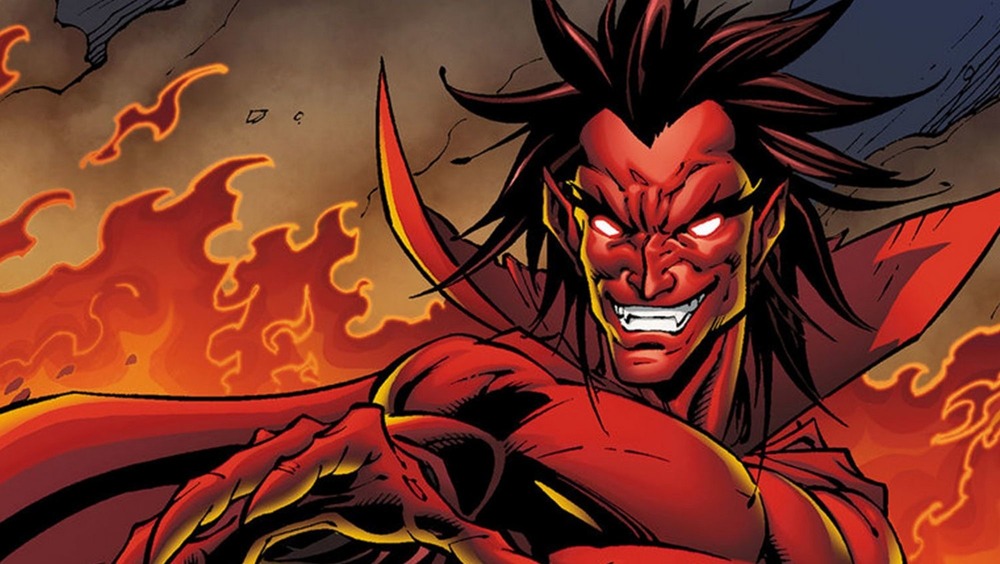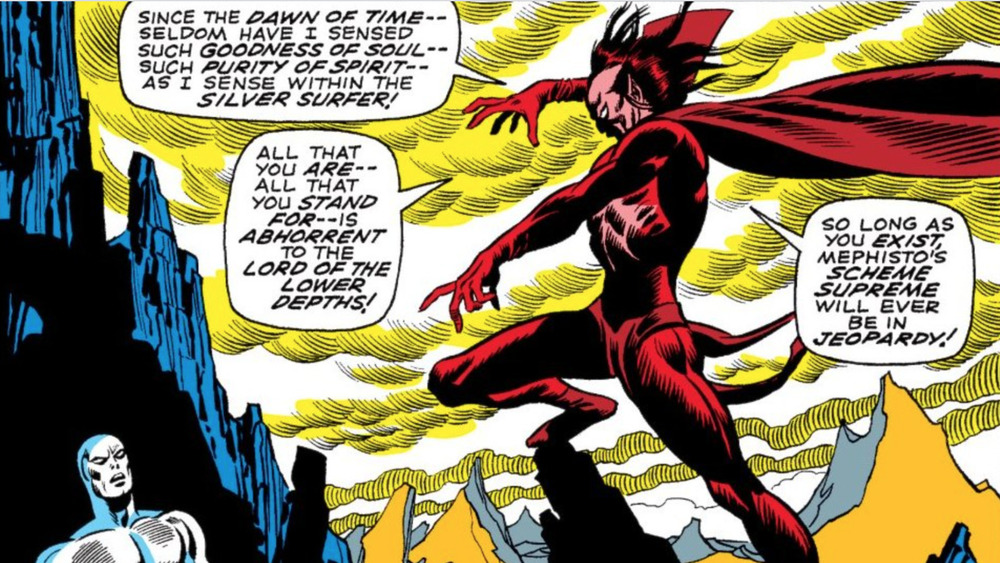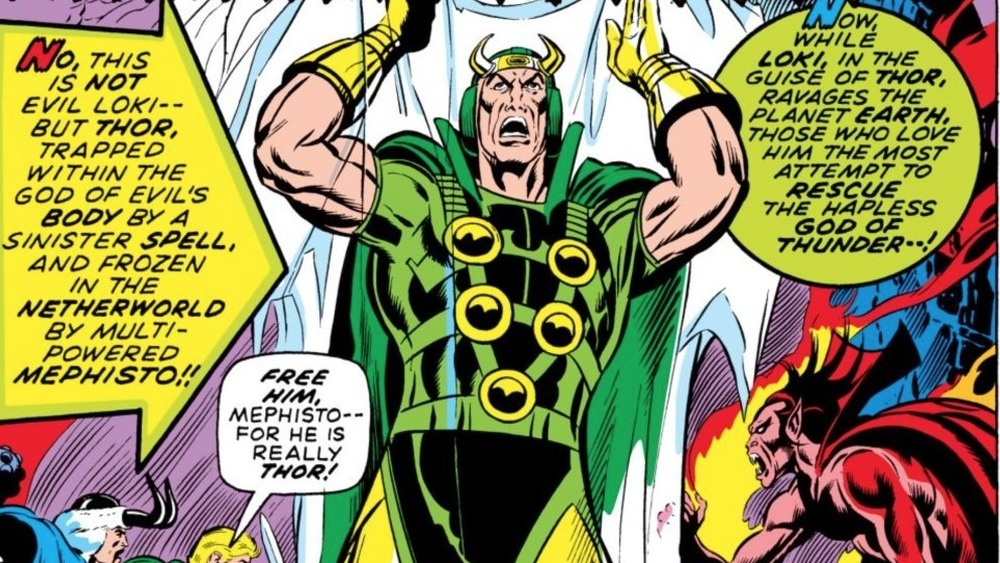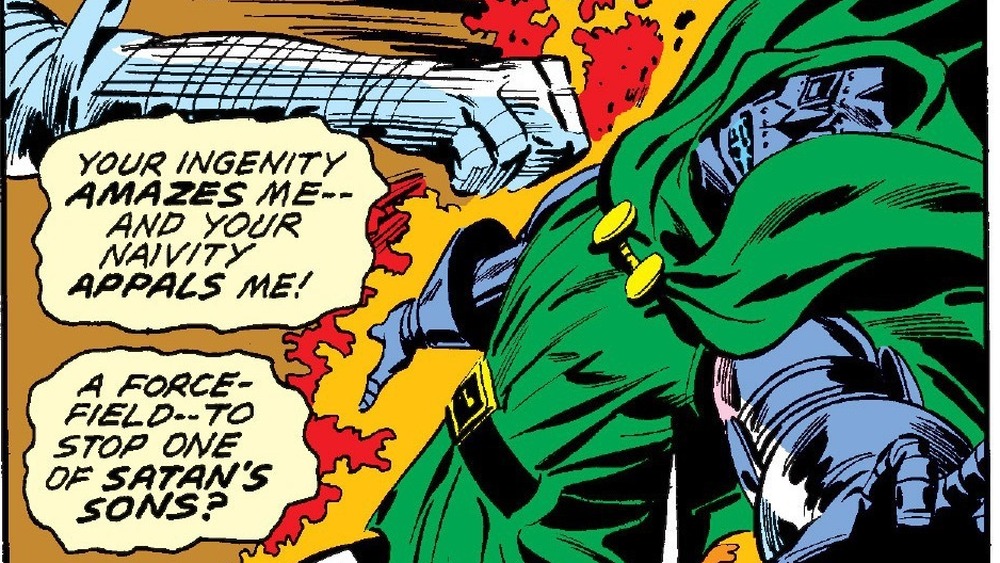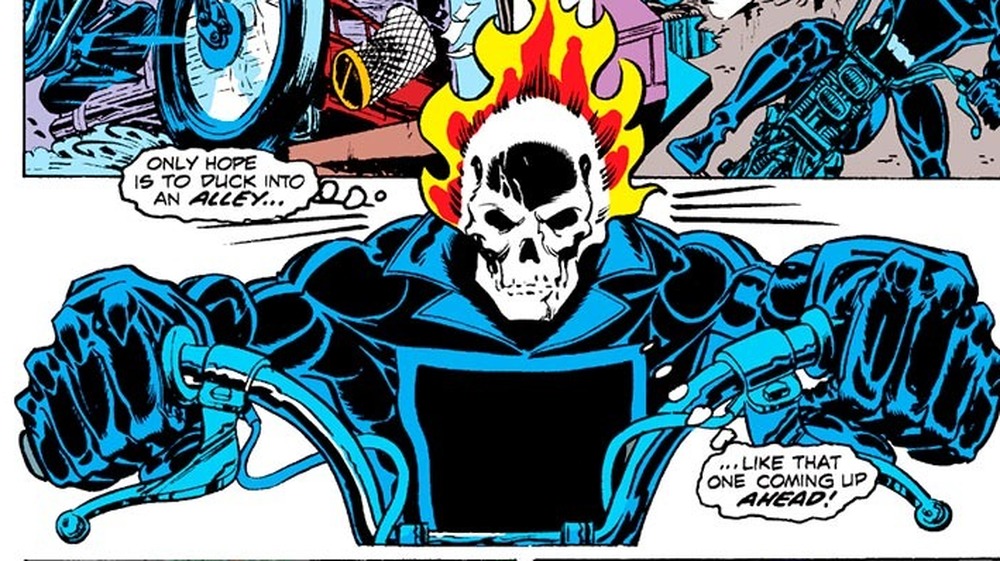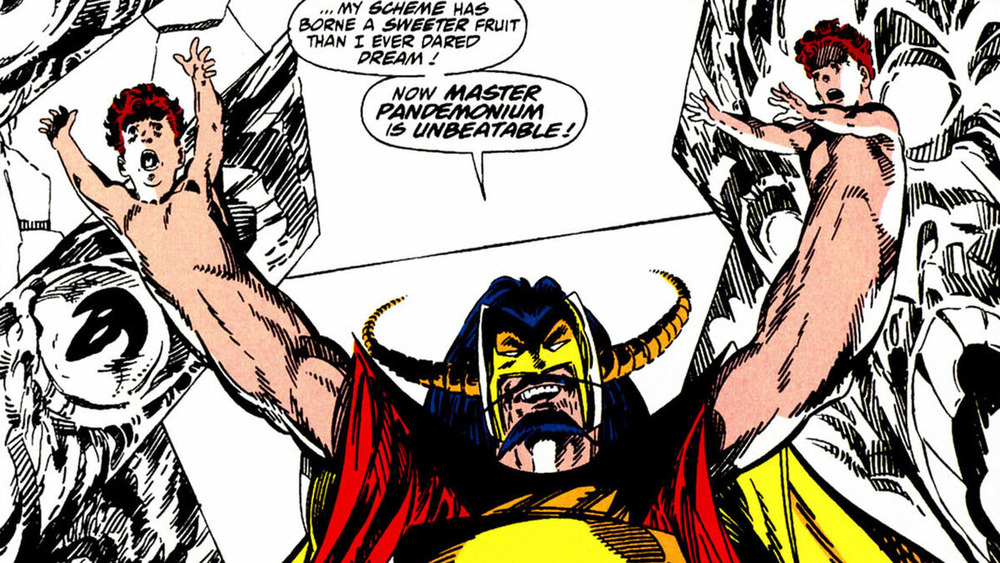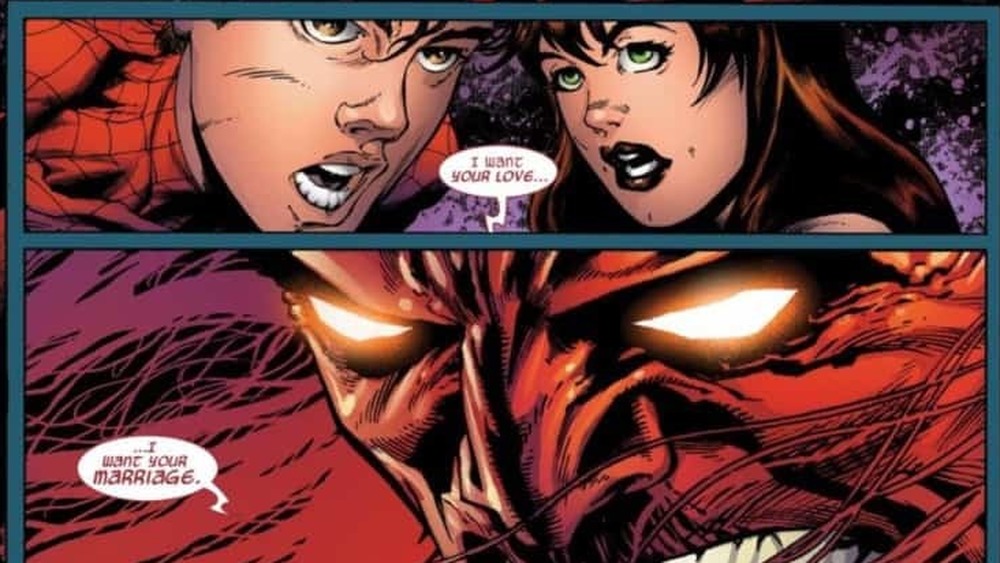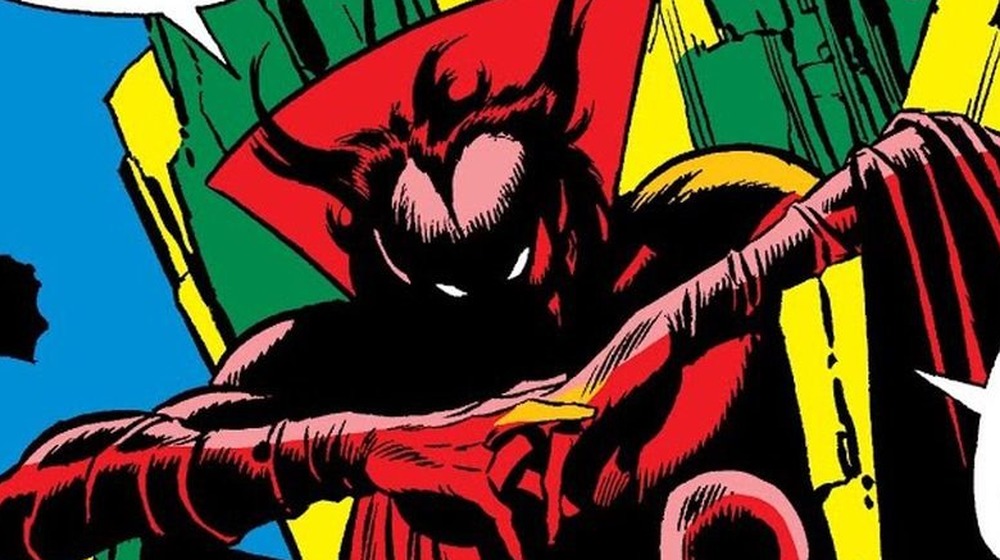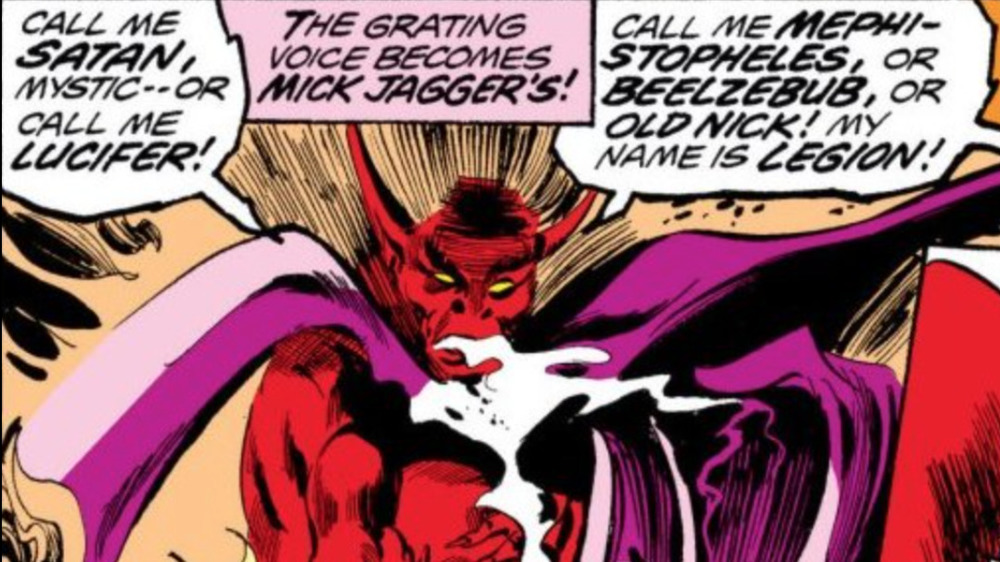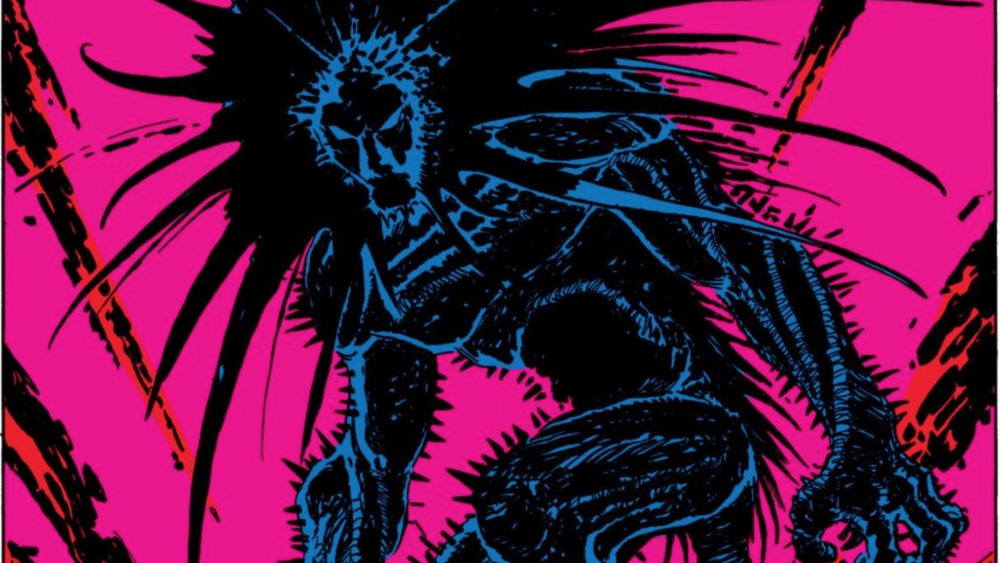The Untold Truth Of Mephisto
Many fictional universes have their own iterations of the Devil and, in the case of Marvel, their iteration is Mephisto, who is based on a demon character from the Faust legend called Mephistopheles. Created by Stan Lee and John Buscema, Mephisto is the lord of the extra-dimensional "Hell"/"Hades" and has an endless craving for living souls, which he acquires through various abilities such as master manipulation, shapeshifting, and of course driving a hard bargain. These deals don't always turn out as planned and as a result, Mephisto usually causes serious problems for the people he makes them with.
Mephisto's craving for souls has put him in contact with many heroes in the Marvel universe, and he's even created of few of his own along the way. He is also in a group called the Hell Lords; each member is a powerful demon who rules over their respective "Hell" dimensions and famously uses the title of "Satan" to manipulate souls. Despite appearing in over 800 Marvel comics and supposedly existing since the dawn of time, there has always been confusion about the origins of Mephisto.
With rumors circulating that the character will appear in the Disney+ miniseries WandaVision, we're here to discuss the history of Mephisto, from his earliest comic appearances to how he could potentially impact the Marvel Cinematic Universe (MCU).
Silver Surfer was Mephisto's first Marvel target
Mephisto's first comic appearance was in 1968's Silver Surfer #3. This issue sees the Surfer angered with humans' constant aggression towards him, so he channels his cosmic powers to bring Earth's civilization to a standstill. This attack catches the attention of Mephisto, who sees Earth as a breeding ground for lost souls. The dark lord uses his "mystic vapors" to reveal the Silver Surfer as the cause of this damage and views the Surfer's nobility and power as a threat to his control of Earth.
Mephisto subsequently travels to the Surfer's former home of Zenn-La and tells his former love Shalla-Bal, who could not see the Surfer after Galactus imprisoned him on Earth, that he can reunite them. Shalla-Bal and Mephisto travel on a spaceship to Earth where the Surfer regrets his actions and reverses the damage. He sees the craft, but Earth forces shoot it down with nukes. The Surfer arrives to revive Shalla-Bal before Mephisto vanishes with her.
Back in Mephisto's lair, the dark lord plans to manipulate the Silver Surfer into becoming his slave, rather than destroying him, when the latter character appears. Mephisto tries to seduce the Surfer with wealth, lust, and power but none of it works and the two fight until Mephisto is defeated. The comic ends with Mephisto sending his enemies away (the Silver Surfer to Earth and Shalla-Bal to Zenn-La) and swearing vengeance against the Surfer.
Thor and Mephisto thundered into battle
Mephisto eventually crosses paths with the God of Thunder in 1980's Thor #180 and #181. In the first issue, Loki switch bodies with Thor and the two clash before Odin, unaware of the body switch, teleports the latter from Earth to Asgard and banishes him to Hades. When Mephisto touches "Loki's" shoulder, he feels pain from Thor's inherent goodness. Realizing the truth, Mephisto attacks Thor but the latter prevails due to his basic understanding of Loki's powers. Sif and the Warriors Three travel to Hades in order to save Thor only to find him, in "Loki's" body, frozen in ice.
The second issue shows Thor's friends fighting Mephisto while the frozen Thor uses Loki's powers to free himself. He then radiates his inner goodness to defeat Mephisto and save his friends. After Mephisto sends the group of heroes to Asgard, Thor realizes that Heimdall will not let him travel the Bifrost bridge in Loki's body, so he travels to Earth to fight Loki. While fighting, Thor tricks Loki into letting go of Mjolnir for 60 seconds, which causes Loki's body to revert to Donald Blake and restore Thor to his original body. Earlier in the comic, Odin tells his Grand Vizier that he knew about the body swap the whole time, so why reveal this information now?
Doctor Doom defended his mother against Mephisto
Mephisto has also faced off against nefarious villains in the Marvel universe such as Doctor Doom. In fact, a story from 1971's Astonishing Tales #8 called "...Though Some Call It Magic!" reveals that Doom's mother, Cynthia von Doom, was a witch who made a deal with Mephisto and whose soul was trapped in Hades to be tortured for all eternity. Each year, Doom uses his mother's spells on the night of Midsummer's Eve, when the barriers between worlds are most easily breached, to win back his mother's soul. Although the comic doesn't specify how many times Doom has faced off against Mephisto before, the dark lord tells the ruler of Latveria that "[his] life will be forfeited" if he loses again. As such, Doom faces off against Mephisto's champion, a stone monster named Kagrok the Killer. While their battle is close, Kagrok brings it to a standstill, and Mephisto lets Doom keep his soul because their yearly struggle "amuses" him.
Mephisto is not mentioned by name in this story, but the 1989 graphic novel Doctor Strange & Doctor Doom: Triumph and Torment confirms that Cynthia did indeed make a deal with him. In that story, Strange and Doom team up to free Cynthia's soul. After rejecting her son's rescue, Cynthia redeems herself and is free to go to a better afterlife. Maybe Doom isn't such a bad guy after all?
Mephisto may have created Ghost Rider
Mephisto is responsible for creating the first iteration of the iconic anti-hero Ghost Rider, not counting the Western character later renamed Phantom Rider. In 1972's Marvel Spotlight #5, former stunt rider Johnny Blaze makes a deal with Satan to stop his mentor and adoptive father Crash Simpson from dying of cancer even though he would die anyway from a failed stunt. When the Devil tries to claim Johnny's soul, Crash's daughter Roxanne came in to drive Satan away using the purity of her love for Johnny. That night, however, Johnny's head became a flaming skull, thus becoming the terrifying creature known as Ghost Rider. While his powers weren't active during the day, Johnny at night (or in the presence of evil) could summon hellfire, ride a flaming motorcycle, and eventually use a "Penance Stare" to make individuals who have stared into his eyes feel every bit of pain they've inflicted onto others. Johnny also could later transform into Ghost Rider at will.
The Satan responsible for Johnny's curse has constantly changed. In 1982's Ghost Rider #68, the Devil that Johnny makes a pact with bears a strong resemblance to Mephisto, and 1983's Ghost Rider #76 confirms that Mephisto disguised himself as Satan and bonded Johnny with the fiery demon Zarathos. 2006's Ghost Rider #5, on the other hand, shows that the Satan from Judeo-Christianity indeed cursed Johnny. Future storylines such as 2018's Damnation disregarded this retcon and show Mephisto creating other Ghost Riders.
Scarlet Witch's Demon Babies have a little Mephisto in them
Mephisto's connection to Wanda Maximoff/Scarlet Witch and her children have had serious consequences for the Marvel universe. 1985 saw the beginning of the second Vision and the Scarlet Witch miniseries where Wanda and her synthetic humanoid husband Vision settle down and try to start a family. Of course, the latter action is next-to-impossible since a biological human can not procreate with a synthetic humanoid. Fortunately, Wanda uses her hex magic to impregnate herself, and the 12-part miniseries ends with her giving birth to twin boys, Thomas and William.
These twins are actually fragments of Mephisto that were scattered after Franklin Richards destroyed the demon's physical essence in 1985's Fantastic Four #276. 1989's Avengers West Coast #51 and #52 see a supervillain named Master Pandemonium kidnap the twins thinking that they would reconstitute him when they were in truth reconstituting Mephisto. After Wanda's children were destroyed, her mentor Agatha Harkness wiped them from her memory. In the "Avengers Disassembled" storyline from 2004, however, an unintentional remark from the Wasp makes Wanda remember her kids and lose her sanity. She subsequently lashes out at the Avengers and causes them to break up.
More craziness ensues but there is a silver lining: Wanda's children are reincarnated as the speedster Speed and the warlock Wiccan. Real names Thomas and William, these Young Avengers were confirmed to be the children of Scarlet Witch in Issue #6 of Avengers: The Children's Crusade, released in 2011.
Spider-Man: One More Day was Mephisto's fault
Mephisto is integral to what is generally considered one of the worst Spider-Man stories ever written: 2007's "One More Day." For those unfamiliar with it, Marvel editor-in-chief Joe Quesada thought that ending the 20-year marriage between Peter Parker and Mary Jane Watson would preserve the longevity of Spider-Man as a character, so he asked J. Michael Straczynski to write this story as the end of his eight-year tenure with the wallcrawler. Quesada even provided art for the four-part miniseries because he thought it was just that special.
The narrative deals with the fallout of the first "Civil War" comic event where Spider-Man reveals his secret identity to the world, so Kingpin sends a sniper to kill Peter who accidentally shoots Aunt May. Even with her on the verge of death, Peter is still desperate to save his aunt despite everyone he's spoken to, including Doctor Strange, saying there's nothing they can do. In comes Mephisto, who tells Peter and MJ that he will save May if they give up their marriage. With a few added caveats, including that the whole world forgets about Peter's secret identity, he and MJ agree to these terms and Mephisto wipes their marriage from existence.
This storyline was universally hated by critics and fans. Straczynski even admitted that he wanted to take his name off the last two issues, so Quesada ended up crediting himself as a co-writer instead. Fortunately, there is still hope that Peter and MJ's marriage will prevail.
Mephisto vs. the Comics Code Authority
Mephisto's realm is not the same Hell that is portrayed in the Bible, and that is mostly because of the Comics Code Authority (CCA). The CCA persuaded American comic book publishers to self-regulate their works and was established in response to two events: the publication of a book in 1954 by psychiatrist Fredric Wertham called Seduction of the Innocent, which vividly details how comics can negatively affect children, and the Senate Subcommittee on Juvenile Delinquency that followed. The CCA seal was voluntary, but parents were less likely to buy comics without one. Unfortunately, the rules that comic publishers had to follow were incredibly strict; some examples include "Ridicule or attack on any religious or racial group is never permissible" and "Scenes dealing with, or instruments associated with walking dead, torture, vampires and vampirism, ghouls, cannibalism, and werewolfism are prohibited."
With all these strict rules, how was Marvel able to create their own Satan in 1968? Per Polygon, Stan Lee and John Buscema envisioned Mephisto as not from this world, which made him more science fiction than supernatural and, as Lee remarked, helped establish the Silver Surfer as a messiah resisting temptation. Fortunately, the CCA in 1971 permitted comics about vampires, ghouls and werewolves if they were "handled in the classic tradition such as Frankenstein, Dracula, and other high caliber literary works" from the likes of Poe and Doyle, which explains why Marvel published the first appearance of Ghost Rider the following year.
Is Mephisto actually Satan?
As Mephisto kept appearing in Marvel comics, many fans continued to wonder if he was truly the Judeo-Christian version of Satan. Luckily, the demon's first encounter with the Sorcerer Supreme in 1976's Doctor Strange #15 and #16 gives some answers: while in hell, Mephisto tells Strange, "Call me Satan, mystic — or call me Lucifer! Call me Mephistopheles, or Beelzebub, or Old Nick! My name is Legion!" The name "Mephisto" is not mentioned in either the Faust legend or these comics, so the Satan that Doctor Strange meets is likely Mephisto disguised as Satan.
A more definitive answer about Mephisto's origin came in the 2020 one-shot comic Spirits of Ghost Rider: Mother of Demons. This comic reveals that before Adam met Eve, he met a supposed fallen angel named Lilith and she mothered many children with him. Unfortunately for her, God did not "appreciate the competition" so he killed Lilith's children and banished her from Eden to Hell. The comic also heavily implies that Lilith's next partner, Mephisto, is the serpent that corrupts Eve in the Book of Genesis.
While Spirits of Ghost Rider suggests that Mephisto is the Biblical Satan from Judeo-Christianity (or at least Marvel's version), it also contradicts the idea that the One Below All is Biblical Satan. This omnipotent being, first introduced in 2018's Immortal Hulk #4, descends from the lowest level of hell and is allegedly more powerful than Mephisto. Hopefully, Marvel will get this all straightened out in the near future.
Treacherous Son
Believe it or not, Mephisto has fathered his own children, with one of his most famous being the demon known as Blackheart. 1989's Daredevil #270 reveals that Mephisto accumulated evil in Christ's Crown, New York to create a tall creature with black skin and long quills; he was later drawn with red eyes in 1990's Daredevil #278. Mephisto taught his son the nature of evil, yet whereas Mephisto needs permission before taking one's soul, Blackheart can take it at will.
With that said, Blackheart is not particularly loyal to his father. In fact, Blackheart often tries to usurp Mephisto as the ruler of his realm, which may explain why the former character is no longer a Hell Lord. In the 1991 comic Ghost Rider/Wolverine/Punisher: Hearts of Darkness #1, Mephisto banishes Blackheart to Earth. The latter asks the titular anti-heroes (Danny Ketch is Ghost Rider at this time) to help him kill his father, but they refuse and fight him instead. Blackheart also tries to conquer Earth as seen in the Falcon series from 2017 and 2018. In that story, Mephisto's son disguises himself as the mayor of Chicago and secretly incites gang violence so that humanity will slowly destroy itself; luckily, Falcon and his apprentice Patriot save the day.
Wes Bentley portrayed Blackheart in the 2007 film Ghost Rider alongside Peter Fonda's Mephisto, who is known in the movie as Mephistopheles.
Mephisto in the MCU
This slide contains major spoilers for WandaVision episodes 1 through 3.
The first two episodes of WandaVision reveal that Wanda's sitcom life takes place within a reality of her own making, but who manipulated her into creating this reality? Mephisto, of course! Fans have found several hints towards his potential appearance throughout the show's first three episodes. In episode 2, the only color in this black-and-white world is ironically red, whether it's the toy helicopter Wanda finds or the blood on Dottie's hand from her cut. Speaking of Dottie, MCU theorists suggest that Wanda's controlling neighbor is Mephisto in disguise. In that same episode, Dottie remarks, "The devil's in the details," to which Wanda's other neighbor Agnes whispers, "That's not the only place he is."
Another indication of Mephisto's presence involves Wanda's children. Throughout the second episode, the people of Westview chant, "For the children," and at the end, Wanda wishes for children before miraculously becoming pregnant. Not to mention these twin boys are born within minutes during episode 3. Maybe Mephisto is using Wanda and Vision's neighbors to encourage the couple to have kids so that he can consume their essence at the end of the season, similar to what happens in the comics.
Additionally, WandaVision is already confirmed to set up Doctor Strange in the Multiverse of Madness and Marvel's Spider-Man 3 so if Mephisto does hurt Wanda, it could have major ramifications on the MCU moving forward.
